Android security is always a hot topic on these here Nets of Inter — and almost always for the wrong reason.
As we've discussed ad nauseam over the years, most of the missives you read about this-or-that super-scary malware/virus/brain-eating-boogie-monster are overly sensationalized accounts tied to theoretical threats with practically zero chance of actually affecting you in the real world. If you look closely, in fact, you'll start to notice that the vast majority of those stories stem from companies that — gasp! — make their money selling malware protection programs for Android phones. (Pure coincidence, right?)
The reality is that Google has some pretty advanced methods of protection in place for Android, and as long as you take advantage of those and use a little common sense, you'll almost certainly be fine (yes, even when the Play Store guards slip up and let the occasional bad app into the gates). The biggest threat you should be thinking about is your own security surrounding your devices and accounts — and all it takes is 20 minutes a year to make sure your setup is sound.
Take the time now to go through this checkup, and set a reminder to revisit this page in another 12 months. Then rest easy the rest of the year knowing you're in good shape — and that the mean ol' Android malware monster won't be bangin' down your virtual door anytime soon.
Part I: App intelligence
Step 1: Look over all the apps and services connected to your account
You've probably granted countless apps access to parts of your Google account over time — which is no big deal in general, but with any apps you're no longer using, it's a smart idea to close the connections.
Visit this page in Google's security settings to see a list of everything that's authorized and what exactly it can access. If you see anything you don't recognize or that you no longer use, click it and then click the blue "Remove Access" button to give it the boot.
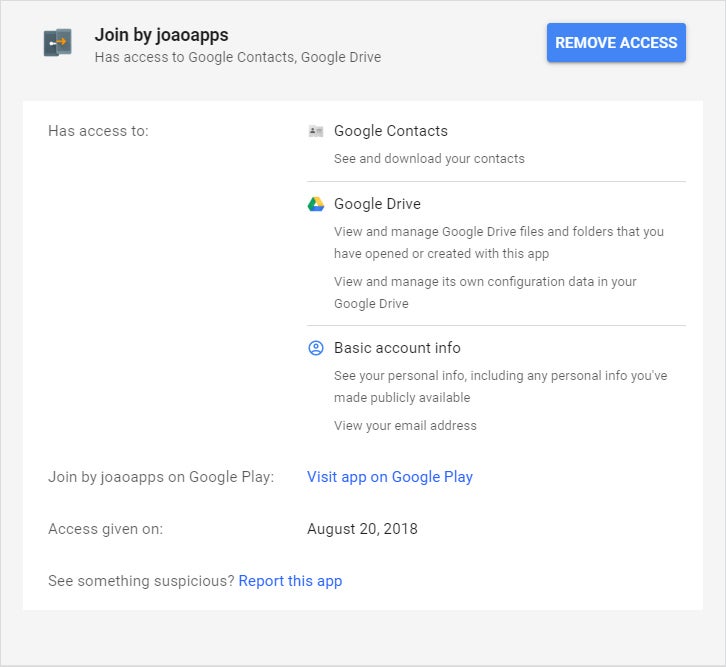 JR
JR Step 2: Revisit your Android app permissions
It's all too easy to grant an app access to some sort of information without giving it much thought during that initial setup process (hi, Facebook!). That's why it's well worth checking in periodically to remind yourself what permissions the apps on your phone possess — and to see if any of them go beyond what seems reasonable or necessary.
Open up the Apps & Notifications section of your system settings, tap "Advanced," then tap either "App permissions" or "Permissions manager." There, you'll see categories for all the types of permissions you've granted to apps on your phone over time.
Take a peek through 'em all and see what you find. If you see anything that raises an eyebrow, all you've gotta do is tap it to revoke the permission.
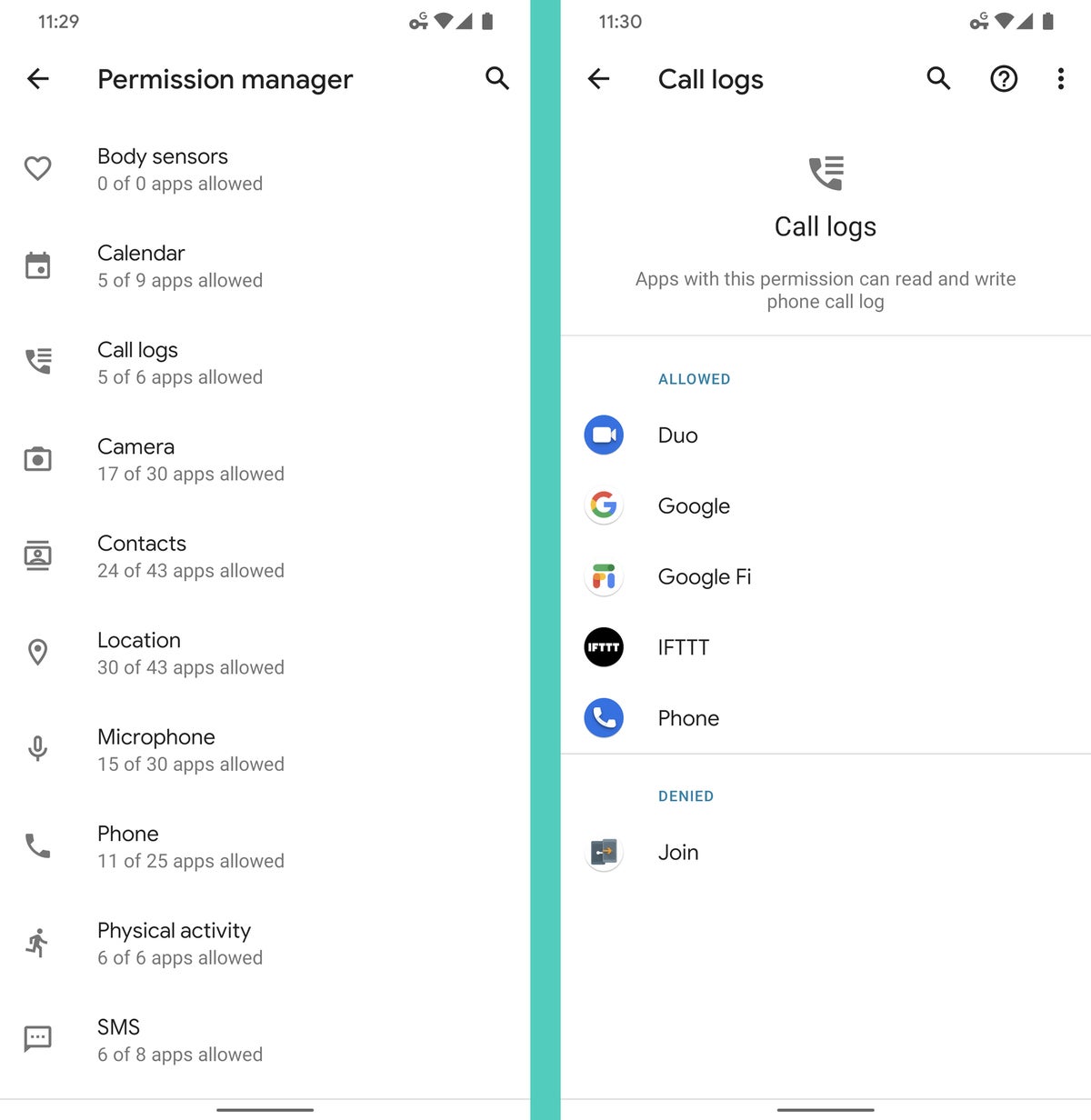 JR
JR And remember, too: As of Android 10, you can actually go a step further when it comes to location and allow an app to access that only when you're actively using it. But, critically, it's up to you to go through your settings and make that change.
Step 3: Verify that you're using Android's app-scanning system
Android has long had the ability to monitor your device for harmful code or suspicious activity — no third-party apps or add-ons required. And while the system should be enabled by default on any reasonably current device, it's a good idea to occasionally confirm that everything's turned on and working the way it should.
Mosey on over to the Security section of your system settings, tap the line labeled "Google Play Protect," and then make sure "Scan device for security threats" is checked. (Depending on your device, you may first have to tap a gear icon in the upper-right corner of the screen in order to see that option.)
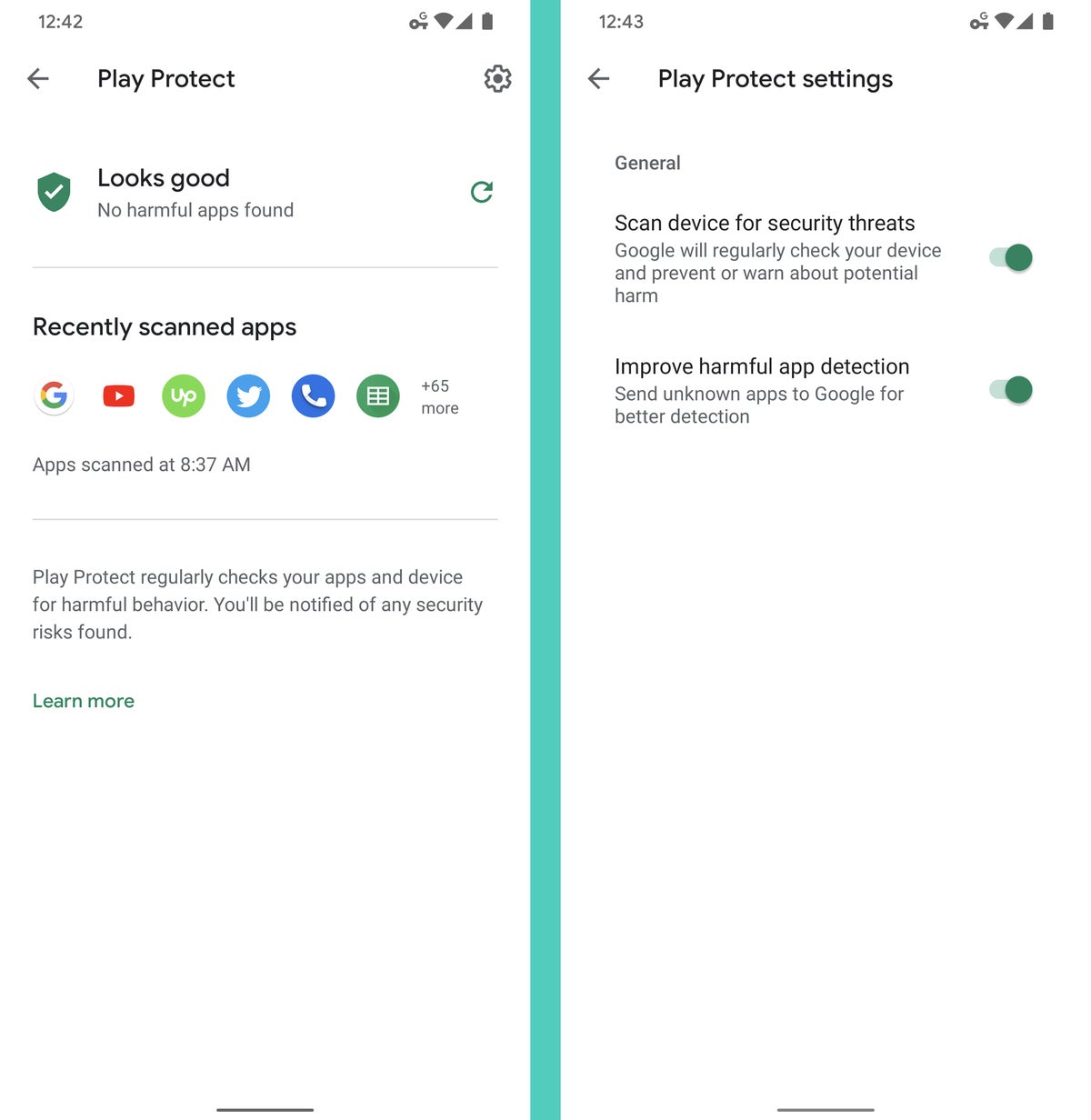 JR
JR That'll allow Android's app verification system to keep an eye on all apps on your device, even after they're installed, and make sure none of them does anything dangerous. The scanning will run silently in the background and won't ever bother you unless something suspicious is found.
Odds are, you'll never even know it's there. But it's a valuable piece of protection and peace of mind to have.
Step 4: Appraise your app-downloading IQ
If you're reading this column, I probably don't need to tell you this — but I will, anyway: While we're thinking about the subject of Android security, take on a teensy bit of responsibility and commit to letting common sense guide your app-downloading decisions.
Look, let's not kid ourselves: Google's security mechanisms are invariably going to fail on occasion. There's no getting around that. But even when a shady app makes its way into the Play Store, all it typically takes is the tiniest shred of awareness to avoid having it affect you in any way.
Just as you do when browsing the web from a computer, look at something before you download it. Look at the number of downloads and the overall reviews. Think about what permissions the app wants and whether you're comfortable with the level of access it requires. Click the name of the developer, if you still aren't sure, and see what else they've created. And unless you really know what you're doing, don't download apps from random websites or other unestablished third-party sources. Such apps will still be scanned by Google's on-device security system before they're installed, but your odds of encountering something shady are significantly greater out in the wild than within the Play Store.
(Your Android device won't let you download apps from unknown sources by default, by the way, so if you ever try — even inadvertently — you'll be warned and prompted to authorize that specific form of non-Play-Store download. Apps on Android will never magically install themselves without your explicit permission.)
By and large, all it takes is a 10-second glance to size something up and see if it's worth installing. With all due respect to the dodos of the world, it doesn't take a rocket scientist to stick with reputable-looking software and avoid questionable creations.
Part II: Passwords and authentication
Step 5: Double-check your security basics
A quick no-brainer that's important to mention: If you aren't using biometric security and/or a PIN, pattern, or password on any of your devices, start doing it. Now.
Talk to any security expert, and you'll hear the same thing: The most likely cause of a security failure is simply a failure on your behalf to secure your stuff. You are the weakest link, as the cool kids said 15 to 20 years ago.
Embarrassingly dated pop culture references aside, think about it: If your phone has no passcode protecting it, all of your data is just out there and waiting for the taking anytime you leave the device unattended (intentionally or otherwise). That includes your email, documents, social media accounts, and entire photo collection (yes, even those pictures — hey, I'm not here to judge).
The best part: Android makes it hassle-free as can be to keep your devices secure. The software's Smart Lock function allows you to automatically leave your phone unlocked in a variety of preapproved "safe" conditions — like when you're at home, when a specific trusted Bluetooth device is connected, or even when the phone is being carried in your pocket. That means the extra security shows up only when it's really needed, and you don't have to mess with it the rest of the time.
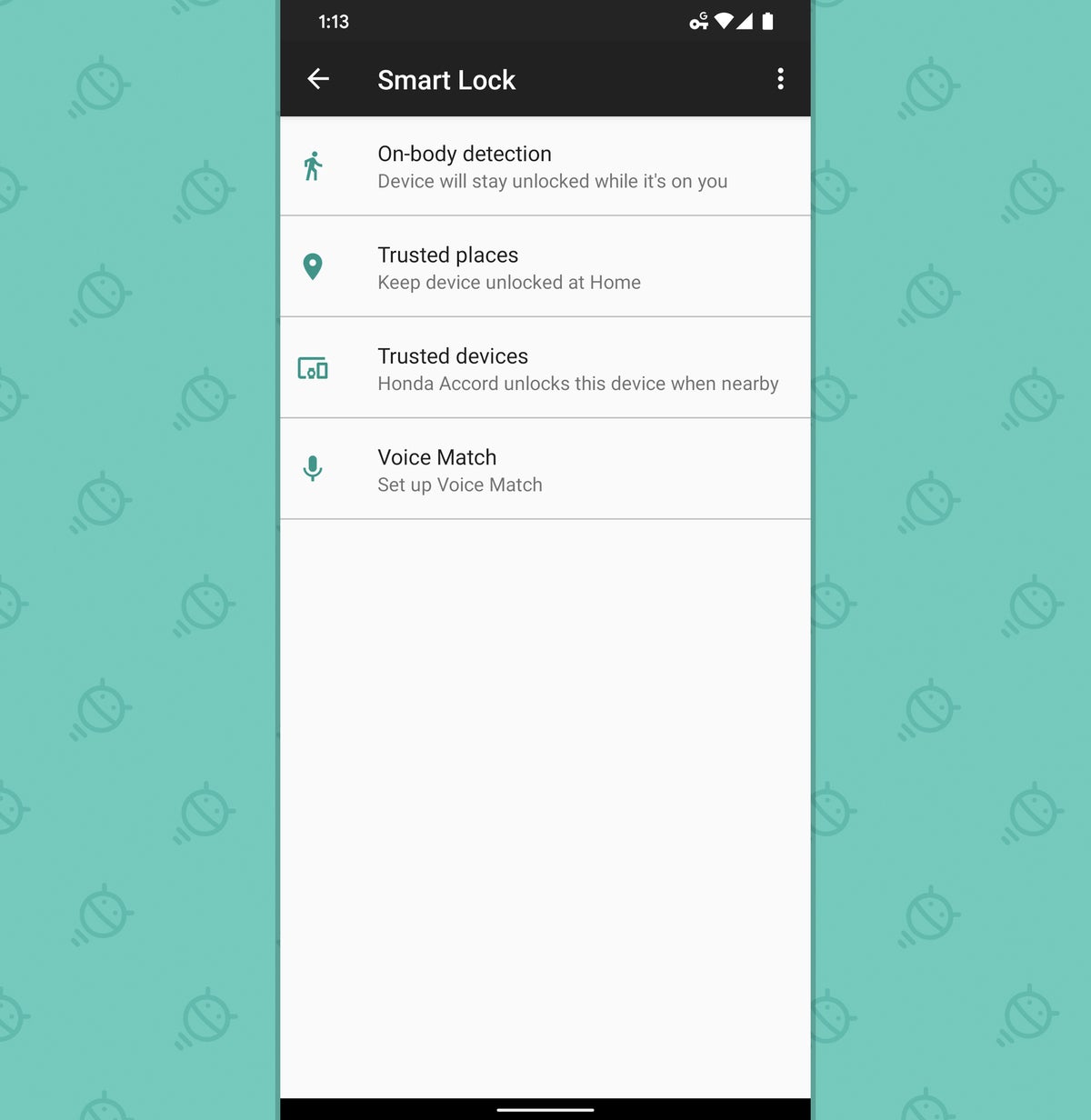 JR
JR Plain and simple, there's no excuse to leave your stuff unprotected. Head into the Security section of your device's settings to get started, if you haven't already.
Step 6: Peek in on your saved Smart Lock passwords
Speaking of Smart Lock, one of the less frequently discussed parts of Google's security system is its ability to save passwords for websites and apps accessed via your mobile devices. As part of your annual checkup, glance over the list of saved passwords Google has for your account so you'll know what's there — and while you're at it, take a few seconds to remove any dated items that are no longer needed and don't belong.
Step 7: Assess your password management system
Google's saved password system is better than nothing, but you'll get stronger security assurances, more advanced and useful features, and broader support for in-app password filling by using a dedicated password management service. Plenty of commendable options are available, but my recommendation for the best all-around experience on Android is LastPass (which has a perfectly serviceable free option and works equally well on the desktop and even on iOS). It makes it easy as can be to generate and store unique secure passwords for every site and service you use and then to fill those passwords in automatically as needed — in any app or browser on practically any platform.
If you aren't using LastPass or another similar service, now's the time to start. And if you are already using such a service, take a few minutes now to peek into the app's settings and make sure you're taking advantage of all the on-device protection it offers. With LastPass, for example, you should confirm that options to lock the app automatically and whenever it's idle for more than a few minutes are active. You should make sure the app requires a PIN or biometric authentication to unlock. And you should confirm that the app is set up for offline access, in case the need ever arises. (All of those options are in the Security section of LastPass's settings.)
LastPass and other password managers also provide an option to analyze all of your passwords and identify any that would be advisable to change — ones that are duplicated or otherwise not as strong as they could be. That's another smart thing to check up on as part of this annual audit.
Step 8: Evaluate your two-factor authentication situation
A single password isn't enough to protect an important account these days — especially one as wide-reaching and valuable as your Google account. Two-factor authentication makes it so that you have to put in a special time-sensitive code in addition to your password anytime you try to sign in. That significantly increases your level of security and decreases the odds of anyone ever being able to break in and access your personal data, since they'd need both knowledge of your password and the physical presence of your code-generating device (most likely your phone) to do it.
If you don't yet have two-factor authentication enabled for your Google account, head over to this site to get started. And don't stop with just Google, either: Look into enabling two-factor authentication on any service that offers it, including your password manager, your social media accounts, and any non-Google cloud storage services that you use. Once you have things configured everywhere, you'll rely on an app like Google's Authenticator to generate single-use codes from your phone or on a third-party alternative like Authy that can run on your phone as well as on other devices.
Speaking of Authy, if you're already using that for two-factor authentication, open the app right now and head into the My Account section of its settings, then tap "App Protection" and confirm that you're using a PIN or fingerprint for protection. Then pop over to the Devices section of the same settings menu to check up on exactly what devices are authorized to access the app. Remove any that are dated and no longer in use.
If you really want to keep your account secure, by the way, Google also now offers a souped-up option called Advanced Protection. It requires you to purchase physical security keys and then use those anytime you sign into your Google account. It also severely limits the ways in which third-party apps can connect to your account. This sort of elevated and locked-down setup probably won't be sensible for most folks, but if you feel like you need the extra protection, you can learn more and enroll here.
Step 9: Optimize your lock screen security
Your lock screen is the guard of your Android device's gate — and there are a few things you can do to beef up its muscle and make sure it's fully prepared for the job.
First, think about the types of notifications you get and how much of that info you want to be visible on your lock screen — since anyone who gets their hands on your phone could easily see all that data. If you tend to get sensitive messages or just want to step up your security and privacy game a notch, head into the Display section of your system settings and select "Lock screen display." (On older devices, you might need to look in the Security section of the settings to find a similar option.)
There, you'll find tools for controlling precisely what will and won't be shown in that pre-authentication area as well as for creating a security-minded message that'll always appear on your lock screen — for instance, something like: "If found, please call Joe T. Schmo at 333-222-1111." You could even consider adding an emergency contact into your settings and then using the lock screen message to direct people to that information.
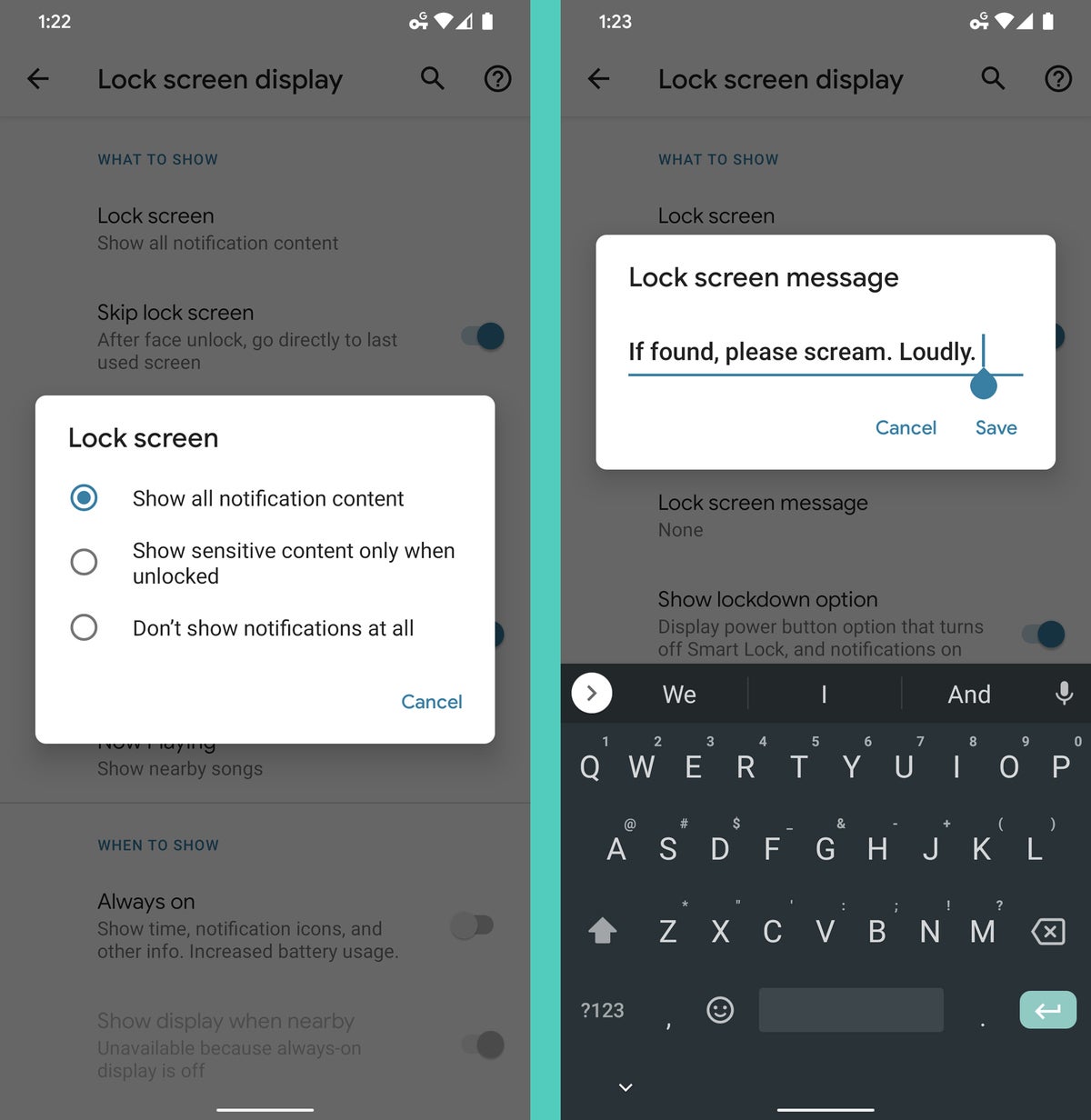 JR
JR And finally, if your phone is running Android 9 or higher, an option called lockdown mode is well worth your while to activate. Once enabled, it gives you a fast way to lock your phone down from all biometric and Smart Lock security options — meaning only a pattern, PIN, or password could get a person past your lock screen and into your device.
The idea is that if you were ever in a situation where you thought you might be forced to unlock your phone with your fingerprint or face — be it by some sort of law enforcement agent or just by a regular ol' hooligan — you could activate the lockdown mode and know your data couldn't be accessed without your explicit permission. Even notifications won't show up on your lock screen when the mode is activated, and that heightened level of protection will remain in place until you manually unlock your phone (even if the device is restarted).
There's just one catch: On some devices, it's up to you to enable the option ahead of time in order for it to be available. But doing so takes only a couple of seconds: In that same "Lock screen display" section of your system settings, simply activate the toggle next to "Show lockdown option" — and that's it.
If the need ever arises, just remember this: While on your lock screen, press and hold your phone's power button for a second or two. There, along with the regular options for restarting and shutting down your device, you'll see the newly present "Lockdown" option. Hopefully, you'll never need it — but now you're ready in case you do.
And with that, guess what? You're more than halfway done with this annual checkup. Not too painful so far, right? Only six more steps to go...
NEXT PAGE: Device access and final considerations
Part III: Device access
Step 10: Clean up your list of connected devices
Anytime you sign into a new device with your Google account — be it an Android phone, a Chromebook, or even just the Chrome browser on a regular PC — that device is added to an approved-for-access list and associated with your account.
Click over to this page in Google's security settings and give your list a once-over. If you see any old devices you no longer use, click on them and then click the "Sign Out" button that pops up to make sure they no longer have access to your account. And if you see any devices you've never used, remove 'em right away — and then go change your account password immediately.
Step 11: Clean up your devices in the Play Store
This one isn't directly related to security, but it's a good bit of housekeeping to perform while you've got your cleaning hat on: Head over to the Google Play Store settings and look at your list of available devices. These are the Android devices that show up as options every time you install a new app from the Play Store web interface — and also the devices that show up as options in Google's Find My Device utility (more on that in a sec).
Go ahead and uncheck the box next to "Show in menus" for any devices you no longer use. And if you see any devices with cryptic codenames, click the "Edit" button alongside them and rename them to something you'll recognize.
 JR
JRThe next time you download an app or remotely locate one of your devices will be a much smoother experience as a result.
Step 12: Make sure your device is prepared for the worst
You might not realize it, but Google has its own utility for tracking, finding, and remotely wiping an Android device in case you ever lose it — and the whole system is built right into the operating system.
So what are you waiting for? Make sure all of your phones and tablets are enrolled now, before it's too late. Just head into the Google section of each device's main settings menu, tap "Security" and then "Find My Device," and make sure the toggle at the top of that section is activated.
Now bookmark the web version of Find My Device and/or download the app on a Chromebook or any other Android-compatible device you own. If you ever can't find your phone or tablet, open the service — or do a Google search for "find my device" in any browser where you're signed in — and you'll be able to pinpoint precisely where the missing gadget was last seen. You can also force the device to ring as well as remotely lock it or erase the thing entirely.
Step 13: Think about whether you should be using a VPN
No matter how secure your Android phone itself is, someone could still snoop on your sensitive info if you're transmitting it over an insecure network. That's where virtual private networks, or VPNs, come into play: They encrypt all of your incoming and outgoing data so that no one could intercept it and see what you're doing at the network level.
VPNs aren't something everyone needs to worry about, but if you use your phone for a fair amount of business work or with any other type of sensitive material, it's probably something you ought to consider — particularly if you use a lot of open Wi-Fi networks, where snooping is especially easy to do.
So where to start? Well, first, some companies provide their own custom VPN services for employees. If that's the case for you, congratulations! You're already all set.
If you're using the Google Fi wireless service, the answer is similarly simple: Fi now provides an option to automatically encrypt all of your network connections via Google's VPN service. All you've gotta do is activate it.
Otherwise, you'll have to turn to a third-party Android VPN service in order to gain that added level of protection.
Part IV: Final considerations
Step 14: Make sure you've done your virtual estate planning
We've got one more "what if" bit of preparation to address — and it's slightly unpleasant to think about: If something bad were ever to happen to you, would you want someone else to be able to access your Google account and all the data associated with your devices? Take a moment to prepare for that possibility now, and it'll make things infinitely easier for your friends or loved ones in the event that you ever develop a mild case of, erm, death.
It's actually pretty painless to do (the preparation, that is — not the death): Just go to this page and make sure you've set up Google's Inactive Account Manager. That system detects when your account has been inactive for a certain period of time — three months, six months, a year, or a year and a half, depending on your preference — and then notifies a friend or loved one of your choosing and provides them with whatever level of access you want. You can even set up an auto-reply to kick in for your Gmail (creepy!), and you can tell Google to delete your account altogether after a specific amount of time has passed.
Inactive Account Manager is designed to be extraordinarily cautious, with numerous fail-safes in place — including an option to try to contact you via SMS and email a month before your inactivity plan goes into action.
 JR
JR Some other services, including LastPass, offer similar systems for setting up emergency access to your account in an extreme situation. It's a weird part of security to consider, but — just like with every other area we've discussed so far — it's something worth thinking about and preparing for before the need arises.
Step 15: Perform a general Google security check to round things out
Take a deep breath: We're almost done! This next-to-last step will take you through a broad security check that'll look for any remaining weak points in your Google account and Android security and then prompt you to fix them right then and there.
Just go to this Google security site and click through any issues it presents. It'll confirm that you've successfully performed many of the actions we've already discussed and will look for any other potential red flags or opportunities for improvement.
Consider it your confirmation that your personal security setup is A-OK.
Step 16: Think carefully about third-party security suites
Last but not least: Now that you've made sure your Android security situation is shipshape, think about any third-party security suites you're using (whether you installed them or they came preinstalled on your phone or tablet) and what they're actually adding to your device. I'm talking Lookout, Avast, Norton, McAfee, AVG — all those sorts of programs.
You've already verified that your device is protected. Android is actively scanning for threats on several levels, both on the server side at the Play Store and on your phone as new apps arrive (from any source) and continuing over time. Plus, you're exercising basic smarts about what apps you download. The operating system is even looking out for SMS-based scams, and the Chrome for Android browser is keeping an eye out for web-based threats as well.
Beyond all of that, your devices are all enrolled in a sophisticated cross-platform system for remotely tracking, pinging, and erasing as needed. And all of that is happening on the native platform level.
So given those layers, is the third-party security suite on your phone doing anything that isn't redundant and unnecessary? It's probably eating up system resources and impacting performance for no real reason — and quite likely also costing you money you don't need to be spending — but is it actually accomplishing anything of value that Android itself isn't already handling in a more direct manner?
The answer is almost certainly no. If having an extra security layer makes you feel safer, hey, do what works for you. But if you've completed every step of this checkup, there's really no reason you need it — and every reason to send it packing. (To be clear, there are some privacy and security apps that could be worth your while; they just aren't the silly, bloated device-scanning suites that are so popular among folks who don't know better.)
And with that, my fellow security-seekers, your checkup is complete. Set your reminder now to revisit these same steps next year. The areas we've just covered are constantly evolving, and giving yourself an annual once-over is the best way to ensure you're always in tip-top shape.
Sign up for my weekly newsletter to get more practical tips, personal recommendations, and plain-English perspective on the news that matters.

https://www.computerworld.com/article/3012630/android-security-checkup.html
2019-12-10 12:00:00Z
CBMiS2h0dHBzOi8vd3d3LmNvbXB1dGVyd29ybGQuY29tL2FydGljbGUvMzAxMjYzMC9hbmRyb2lkLXNlY3VyaXR5LWNoZWNrdXAuaHRtbNIBT2h0dHBzOi8vd3d3LmNvbXB1dGVyd29ybGQuY29tL2FydGljbGUvMzAxMjYzMC9hbmRyb2lkLXNlY3VyaXR5LWNoZWNrdXAuYW1wLmh0bWw
Bagikan Berita Ini














0 Response to "Android security checkup: 16 steps to a safer phone - Computerworld"
Post a Comment